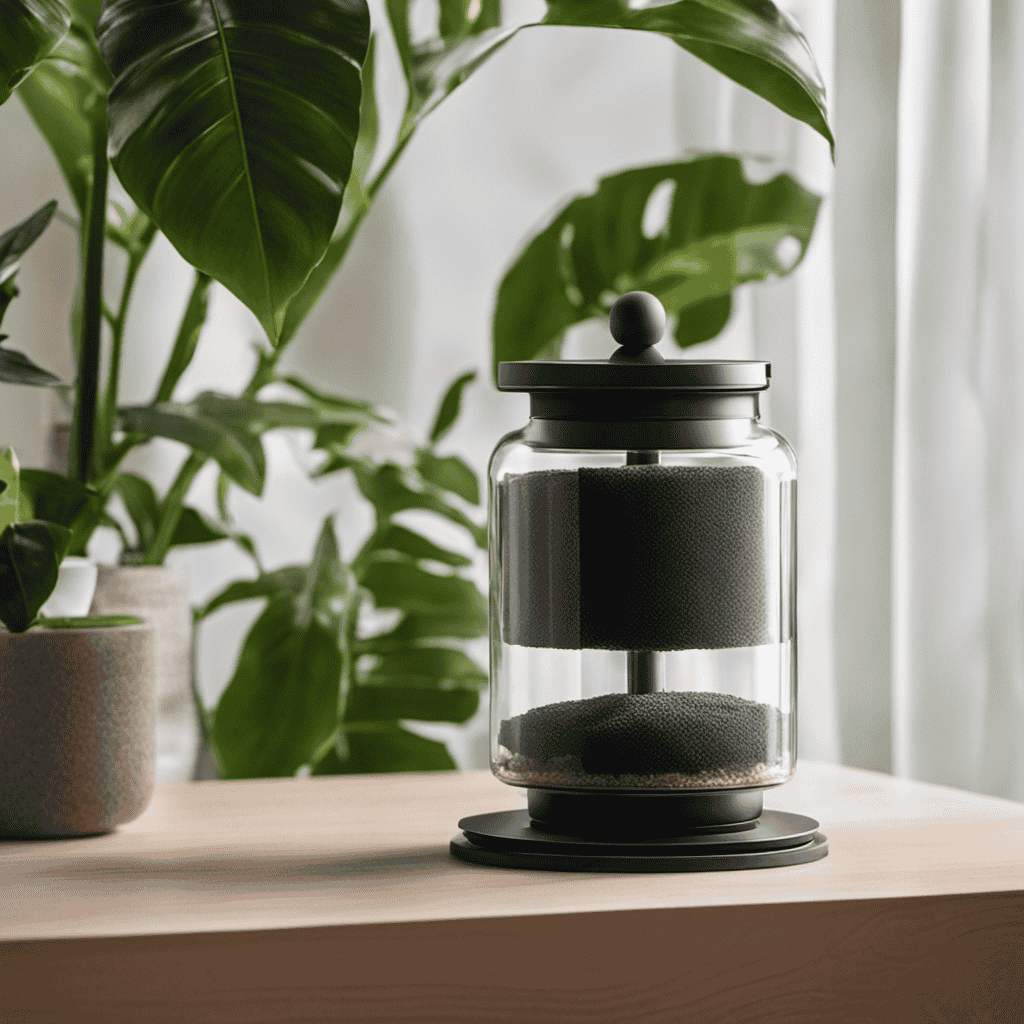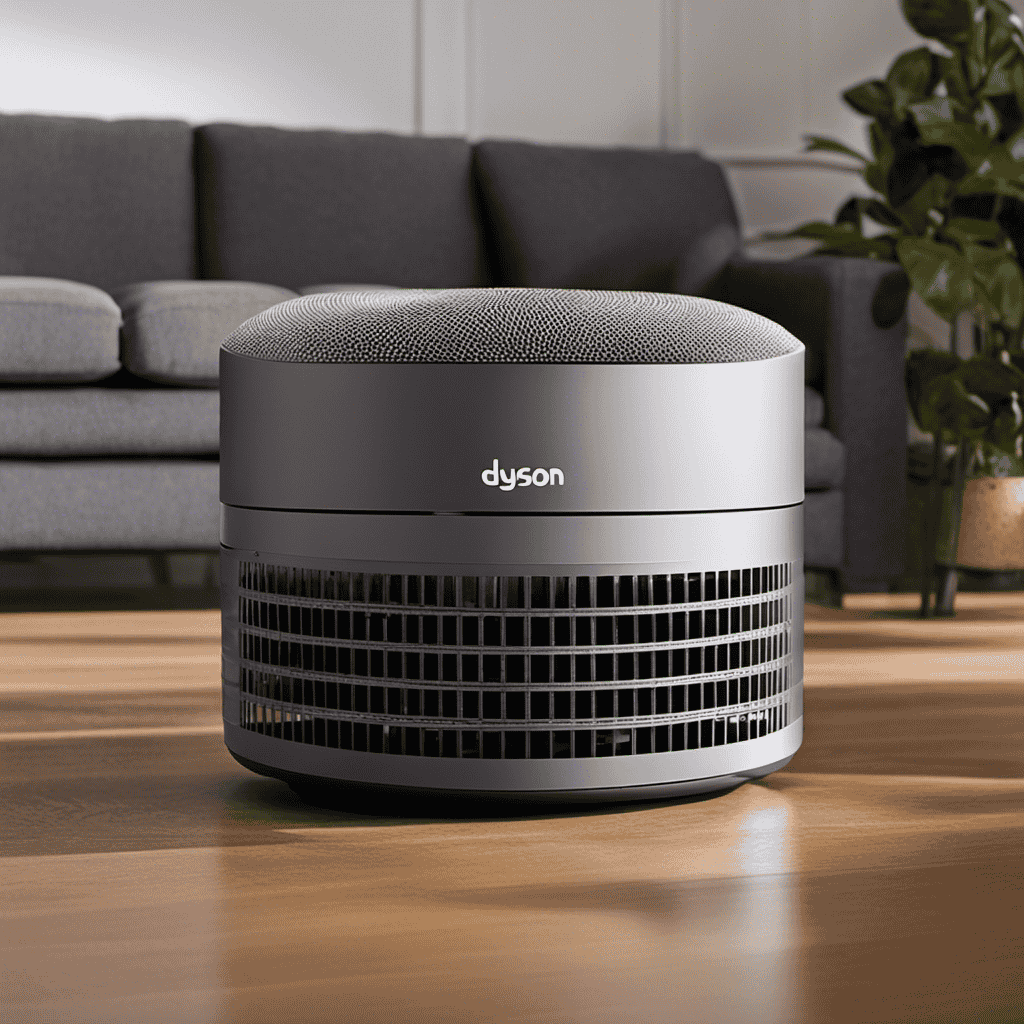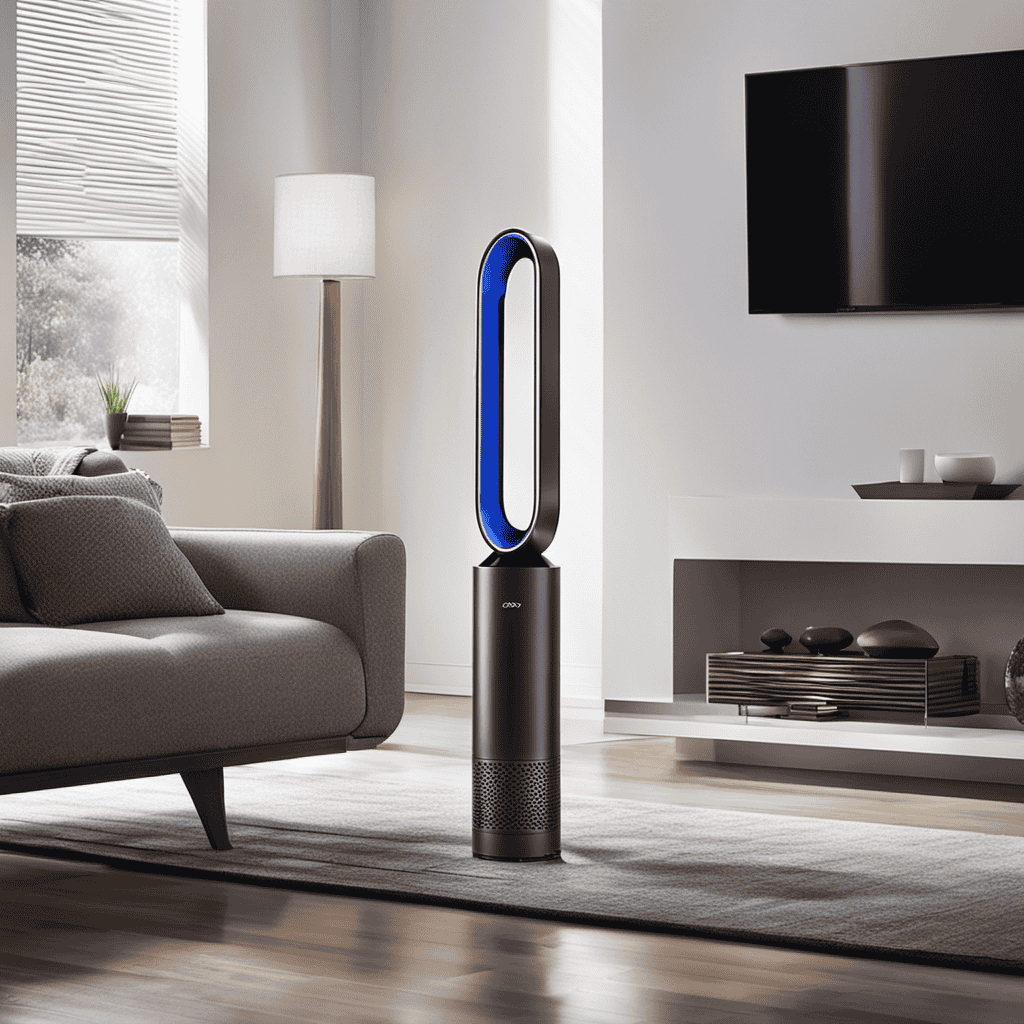As someone who values clean and fresh air in my home, I often find myself searching for ways to purify the air without relying on an air purifier.
It’s like navigating through a maze, trying to find the best solutions. Luckily, I’ve gathered a wealth of knowledge and practical tips along the way.
In this article, I’ll share my insights on how to improve indoor air quality using natural methods and simple lifestyle changes. Get ready to breathe easier and enjoy a healthier living environment.
Key Takeaways
- Open windows and doors to let fresh air in and remove pollutants.
- Use natural air filters like peace lilies and spider plants to absorb toxins and release oxygen.
- Incorporate air-purifying houseplants like snake plants, peace lilies, spider plants, aloe vera, and English ivy.
- Utilize natural air purification methods such as homemade air fresheners with essential oils and keeping homes clean.
Understanding the Importance of Air Quality
You need to understand why air quality is important in your home.
Air quality monitoring is crucial because poor air quality can have serious health effects. Indoor air pollution can lead to respiratory problems, allergies, and even chronic diseases. Dust, pet dander, mold, and chemicals from cleaning products can all contribute to poor air quality. Inadequate ventilation and high humidity levels can also worsen the problem.
Monitoring the air quality in your home allows you to identify potential pollutants and take necessary steps to improve it. Regularly cleaning and vacuuming, using air purifiers, and ensuring proper ventilation can all help maintain good air quality.
Identifying Common Indoor Air Pollutants
To identify common indoor air pollutants, start by looking for sources of dust, pet dander, and pollen. These are some of the most common culprits that can affect the air quality in your home. However, there are many other pollutants that can also be present. It’s important to be aware of these pollutants in order to take steps towards improving indoor air quality. Here is a table that lists some common indoor pollutants and their sources:
| Pollutant | Source |
|---|---|
| Volatile Organic Compounds (VOCs) | Cleaning products, paints, adhesives |
| Carbon Monoxide | Gas stoves, fireplaces, furnaces |
| Mold Spores | Damp areas, leaks, high humidity levels |
| Tobacco Smoke | Smoking indoors, secondhand smoke |
Natural Ways to Improve Air Circulation
One way to improve air circulation naturally is by opening windows and doors to let fresh air in. This allows for the exchange of stale indoor air with fresh outdoor air, helping to remove pollutants and improve overall air quality.
In addition to this simple step, there are other natural methods you can use to enhance air circulation in your home.
-
Use natural air filters: Certain plants, such as peace lilies and spider plants, can act as natural air filters by absorbing toxins and releasing oxygen. Consider placing these plants strategically around your home to improve air quality.
-
Make homemade air fresheners: Instead of using chemical-laden air fresheners, create your own using natural ingredients like essential oils and baking soda. These can help eliminate odors while keeping the air fresh and clean.
-
Clean and declutter: Regularly clean and declutter your living spaces to remove dust, pet dander, and other allergens that can impede air circulation.
-
Utilize ceiling fans: Ceiling fans can improve air circulation by creating a gentle breeze, helping to distribute fresh air throughout the room.
-
Maintain proper ventilation: Ensure that vents, ducts, and exhaust fans are clean and in good working condition to facilitate proper air circulation.
Using Houseplants for Air Purification
I’ve always been interested in finding natural ways to improve the air quality in my home. Using houseplants for air purification is one method that has caught my attention.
There are several houseplants that are known for their air-purifying properties. Some examples include the snake plant, spider plant, and peace lily.
Not only can these plants help remove toxins from the air, but they also provide other benefits. For instance, they can increase humidity and reduce stress levels.
Best Air-Purifying Houseplants
The best way to purify the air in your home without an air purifier is by using houseplants. Houseplants have been proven to filter out common indoor air pollutants, such as benzene, formaldehyde, and trichloroethylene, while also releasing oxygen and increasing humidity.
Here are five air-purifying houseplants that are particularly effective:
- Snake Plant (Sansevieria): Removes formaldehyde and benzene.
- Peace Lily (Spathiphyllum): Eliminates formaldehyde, benzene, and trichloroethylene.
- Spider Plant (Chlorophytum comosum): Filters out formaldehyde and xylene.
- Aloe Vera (Aloe barbadensis): Cleanses formaldehyde and benzene.
- English Ivy (Hedera helix): Targets airborne mold and fecal matter.
These houseplants not only add beauty to your home but also improve air quality by reducing allergens and toxins. By incorporating these plants into your indoor space, you can create a healthier environment for you and your family.
Transitioning to the benefits of natural purification, let’s explore other ways nature can help cleanse the air.
Benefits of Natural Purification
Now that we have discussed the best air-purifying houseplants, let’s explore the benefits of natural air purification and how indoor plants can serve as natural air fresheners.
Indoor plants not only add beauty and life to our homes but also have the ability to filter and purify the air we breathe. They do this by absorbing harmful gases, such as carbon dioxide, and releasing oxygen through photosynthesis.
Additionally, certain plants, like the peace lily and snake plant, have been found to remove toxins, such as formaldehyde and benzene, from the air. Studies have shown that having indoor plants can improve air quality, reduce stress levels, increase productivity, and even boost our mood.
Eliminating Sources of Indoor Pollution
When it comes to improving indoor air quality, there are several natural air purification methods that can be effective.
One key approach is to reduce the presence of chemical pollutants in our homes. Chemical pollutants, such as volatile organic compounds (VOCs), can be emitted from various household products and can have detrimental effects on our health.
Natural Air Purification Methods
One effective way to purify the air in your home without an air purifier is by using natural methods. These methods not only help to remove pollutants from the air but also add a fresh and pleasant scent to your living space.
Here are some natural air purification methods you can try:
-
Use plants as natural air filters. Certain plants, such as aloe vera, spider plants, and peace lilies, have air-purifying properties and can help remove toxins from the air.
-
Make homemade air fresheners using natural ingredients like essential oils, baking soda, and vinegar. These can help neutralize odors and improve indoor air quality.
-
Open windows and doors regularly to allow fresh air to circulate and flush out pollutants.
-
Keep your home clean and dust-free to reduce the accumulation of allergens and airborne particles.
-
Use natural cleaning products that are free from harsh chemicals to minimize indoor air pollution.
Reducing Chemical Pollutants
Using natural cleaning products that are free from harsh chemicals can help reduce the presence of chemical pollutants in your living space.
Harsh cleaning chemicals can release volatile organic compounds (VOCs) into the air, which can contribute to indoor air pollution. By choosing natural alternatives, such as vinegar, baking soda, and lemon juice, you can effectively clean your home without introducing additional toxins.
In addition to using natural cleaning products, there are other ways to reduce chemical pollutants in the air. Ensuring proper ventilation in your home, such as opening windows and using exhaust fans, can help remove indoor air pollutants.
Regularly changing air filters in heating and cooling systems is also important for reducing allergens and improving indoor air quality.
Cleaning and Maintaining Ventilation Systems
To clean and maintain your ventilation systems, start by regularly changing the air filters in your home. This simple task helps to remove dust, allergens, and other particles from the air, ensuring that your ventilation system functions efficiently.
Additionally, cleaning air ducts is essential for preventing mold growth and improving indoor air quality. Here are some key steps to consider:
- Inspect your air ducts for any visible signs of mold or dust buildup.
- Use a vacuum cleaner with a HEPA filter to remove loose debris from the ducts.
- Consider hiring a professional duct cleaning service for a more thorough cleaning.
- Ensure that your vents and registers are not blocked by furniture or other objects.
- Maintain proper humidity levels in your home to prevent mold growth.
Proper Humidity Control for Better Air Quality
When it comes to maintaining a healthy indoor environment, proper humidity control is crucial. Understanding the ideal humidity levels for your home, the differences between a dehumidifier and a humidifier, and the benefits of maintaining proper humidity can greatly improve air quality.
Ideal Humidity Levels
Maintaining ideal humidity levels in your home will help purify the air without an air purifier. High humidity can have a negative impact on indoor air quality, promoting the growth of mold, dust mites, and other allergens. By controlling the humidity, you can create a healthier environment for you and your family.
Here are five reasons why maintaining ideal humidity levels is important:
- Prevents the growth of mold and mildew, which can trigger allergies and respiratory issues.
- Reduces the presence of dust mites, a common indoor allergen.
- Helps prevent the spread of airborne viruses and bacteria.
- Improves the efficiency and lifespan of your HVAC system.
- Enhances overall comfort by reducing sticky and clammy feelings.
To maintain ideal humidity levels, consider using a dehumidifier or implementing simple measures like proper ventilation, regular cleaning, and repairing any water leaks. By taking these steps, you can improve the air quality in your home and promote a healthier living environment.
Dehumidifier Vs Humidifier
Using a dehumidifier or a humidifier can help you control the humidity levels in your home. Both devices have their own benefits and are used in different situations. A dehumidifier is used to remove excess moisture from the air, while a humidifier adds moisture to the air.
When it comes to air moisture control, it is important to understand the effects of high humidity on our health. High humidity can create an environment that promotes the growth of mold, dust mites, and other allergens. This can lead to respiratory problems, allergies, and even asthma attacks. On the other hand, low humidity can cause dry skin, itchy eyes, and respiratory irritation.
To determine whether you need a dehumidifier or a humidifier, you can consider factors such as the current humidity levels in your home, the climate you live in, and your personal comfort preferences. It is also recommended to consult with a professional or do some research to find the best option for your specific needs.
| Factors to Consider | Dehumidifier | Humidifier |
|---|---|---|
| Current Humidity Levels | High humidity levels | Low humidity levels |
| Climate | Hot and humid climates are more prone to high humidity levels | Dry and cold climates are more prone to low humidity levels |
| Health Concerns | Beneficial for those with allergies, asthma, and respiratory issues | Beneficial for those with dry skin, sinus problems, and allergies |
Benefits of Proper Humidity
To maintain a healthy environment, it’s important for you to understand the benefits of maintaining proper humidity levels in your home. Proper humidity control can have numerous health benefits for you and your family. Here are five key benefits to consider:
-
Improved respiratory health: Maintaining proper humidity levels can help alleviate symptoms of respiratory conditions such as asthma and allergies.
-
Enhanced immune system: Optimal humidity levels can help support a stronger immune system, reducing the risk of catching colds or other illnesses.
-
Prevents dry skin and irritation: Adequate humidity can keep your skin moisturized, preventing dryness, itchiness, and irritation.
-
Protects furniture and woodwork: Proper humidity levels can prevent wood from drying out and cracking, extending the lifespan of your furniture and woodwork.
-
Reduces static electricity: Balanced humidity levels can help reduce static electricity, which can be a nuisance and even cause damage to electronics.
Utilizing Essential Oils for Air Purification
Did you know that essential oils can effectively purify the air in your home without the use of an air purifier? Essential oils have natural properties that can help eliminate airborne bacteria, viruses, and odors. One popular way to use essential oils for air purification is through the use of essential oil diffusers. These diffusers release the oils into the air, allowing their aromatic molecules to cleanse and refresh the indoor environment. Another option is to make homemade air fresheners using essential oils. Simply mix a few drops of your favorite oil with water in a spray bottle and mist it around your home. To give you an idea of the different essential oils you can use for air purification, here is a table showcasing some popular options:
| Essential Oil | Air Purifying Properties |
|---|---|
| Tea Tree | Antimicrobial |
| Lavender | Antifungal |
| Eucalyptus | Decongestant |
| Lemon | Antiseptic |
| Peppermint | Energizing |
The Benefits of Opening Windows and Doors
Opening the windows and doors in your home allows fresh air to circulate, improving indoor air quality. This natural ventilation option has several benefits:
-
Removes indoor pollutants: Opening the windows and doors helps to remove pollutants such as volatile organic compounds (VOCs), smoke, and odors, reducing the risk of respiratory issues and allergies.
-
Regulates moisture levels: Proper air circulation helps to prevent excess moisture buildup, which can lead to mold growth and other moisture-related problems.
-
Increases oxygen levels: Fresh air from outside contains higher levels of oxygen, which can boost alertness, improve concentration, and enhance overall well-being.
-
Reduces indoor temperatures: Opening windows and doors allows for cross ventilation, helping to cool down the indoor space during hot and humid weather.
-
Enhances mood and productivity: Breathing in fresh air can have a positive impact on mood, reducing stress and increasing productivity.
Incorporating natural ventilation options by regularly opening windows and doors can greatly improve the air quality in your home, benefiting both your physical and mental well-being.
Removing Carpet and Opting for Hard Flooring
When it comes to choosing between carpet and hard flooring, the air quality benefits of hard flooring are undeniable. Carpets can trap dust, allergens, and pet dander, leading to poor indoor air quality.
On the other hand, hard flooring, such as hardwood or laminate, is much easier to clean and doesn’t harbor these pollutants, thereby improving the air quality in your home.
Carpet Vs Hard Flooring
There are benefits to both carpet and hard flooring when it comes to purifying the air in your home. Carpet can act as a passive air filter, trapping dust, allergens, and other particles that can be vacuumed away. On the other hand, hard flooring, such as hardwood or tile, is easier to clean and doesn’t harbor as many allergens.
Here are some benefits of tile flooring:
- Tile flooring is non-porous, which means it doesn’t absorb odors or release volatile organic compounds (VOCs) into the air.
- It is highly durable and long-lasting, minimizing the need for frequent replacements.
- Tile is easy to clean, reducing the accumulation of dust and allergens.
- It doesn’t trap moisture, preventing the growth of mold and bacteria.
- Tile can help maintain a cooler indoor temperature, reducing the need for air conditioning.
Air Quality Benefits
When it comes to air quality, there are numerous benefits to be gained from natural air purification methods. These methods not only help to remove pollutants from the air but also provide a range of health benefits. One of the main advantages is the reduction of indoor air pollution, which can lead to respiratory issues and other health problems. Natural air purification also helps to eliminate odors, making your home smell fresh and clean. Additionally, it can improve sleep quality by providing a cleaner and healthier environment. To illustrate the air purifying benefits of natural methods, consider the following table:
| Air Purifying Benefits | Natural Methods |
|---|---|
| Removes pollutants | Indoor plants |
| Eliminates odors | Salt lamps |
| Improves sleep quality | Beeswax candles |
| Reduces respiratory issues | Essential oils |
Filtering Air With DIY Air Purifiers
Using DIY air purifiers is an effective way to filter the air in your home. These DIY alternatives offer a cost-effective solution to improve indoor air quality without the need for expensive air purifiers.
Here are some homemade air filters that you can easily create:
- Activated charcoal and cheesecloth: Charcoal absorbs odors and pollutants, while cheesecloth acts as a filter.
- Beeswax candles: Beeswax candles release negative ions that can help remove airborne particles.
- Houseplants: Certain plants like spider plants and peace lilies can naturally filter toxins from the air.
- Baking soda: Placing bowls of baking soda around your home can help absorb odors.
- Essential oil diffusers: Adding a few drops of essential oils like tea tree or eucalyptus can help purify the air and add a pleasant aroma.
By incorporating these DIY air purifiers into your home, you can improve air quality and create a healthier living environment.
Now, let’s explore another important aspect of maintaining clean air: avoiding chemical-based cleaning products.
Avoiding Chemical-Based Cleaning Products
To maintain clean air, you should avoid using chemical-based cleaning products in your household. These products often contain volatile organic compounds (VOCs) that can be harmful to your respiratory system and contribute to indoor air pollution.
Instead, consider using natural alternatives and homemade cleaning solutions. For example, you can make an all-purpose cleaner by mixing equal parts water and vinegar. Vinegar is a natural disinfectant and can help remove dirt and grime. Baking soda is another effective ingredient that can be used to clean and deodorize various surfaces.
It is important to note that homemade cleaning solutions may not have the same level of effectiveness as chemical-based products, so you may need to put in a little extra effort. However, by choosing natural alternatives, you can help reduce the amount of harmful chemicals released into your home’s air.
The Role of Air Purifying Foods and Drinks
Now that we’ve discussed the importance of avoiding chemical-based cleaning products, let’s explore another natural way to purify the air in our homes. Did you know that certain spices and teas have air purifying properties? Incorporating these into our daily lives can help improve the air quality in our homes.
Cinnamon: This aromatic spice not only adds flavor to our food but also acts as an air purifier, eliminating odors and harmful bacteria.
Basil: Known for its culinary uses, basil also releases essential oils that can purify the air and improve respiratory health.
Peppermint tea: Besides being a refreshing beverage, peppermint tea has menthol, which can clear the airways and provide relief from congestion.
Green tea: Packed with antioxidants, green tea can help neutralize pollutants and improve overall air quality.
Ginger: This versatile spice not only adds a kick to our meals but also has antimicrobial properties that can cleanse the air.
Enhancing Air Quality Through Proper Ventilation
Proper ventilation is crucial in improving the quality of the air in our homes. By allowing fresh air to circulate and removing pollutants, we can create a healthier living environment. There are several benefits of proper ventilation, as shown in the table below:
| Benefits of Proper Ventilation |
|---|
| Reduces indoor air pollutants |
| Prevents mold and mildew growth |
| Regulates humidity levels |
| Removes odors |
| Improves overall air quality |
Improving air quality through proper ventilation not only ensures a more pleasant and comfortable living space, but also has positive effects on our health. By reducing exposure to harmful pollutants, such as volatile organic compounds (VOCs) and allergens, we can decrease the risk of respiratory issues and allergies. It is essential to have a well-ventilated home to create a clean and healthy environment for ourselves and our loved ones, which leads us to the next section about creating a clean and clutter-free living space.
Creating a Clean and Clutter-Free Living Space
Creating a clean and clutter-free living space is essential for maintaining a tidy and organized home. Not only does it make your home look more visually appealing, but it also promotes better mental and physical health.
Here are some cleaning tips and organizing strategies to help you achieve a clean and clutter-free living space:
- Regularly declutter and get rid of items you no longer need or use.
- Implement a cleaning routine that includes dusting, vacuuming, and mopping regularly.
- Utilize storage solutions such as bins, baskets, and shelves to keep items organized.
- Make sure everything has a designated place to avoid unnecessary clutter.
- Develop habits like putting things away immediately after use to avoid accumulation of clutter.
Frequently Asked Questions
How Can I Determine the Air Quality in My Home?
I determine the air quality in my home by using air quality monitoring devices or conducting DIY air quality tests. These methods provide objective and evidence-based results to assess the cleanliness and safety of the air I breathe.
What Are Some Common Indoor Air Pollutants That I Should Be Aware Of?
Some common indoor air pollutants to be aware of include volatile organic compounds, dust mites, mold, and pet dander. Poor air quality can lead to respiratory issues, allergies, and other health problems.
Can Houseplants Really Help in Purifying the Air?
Houseplants can help purify the air by removing toxins and releasing oxygen. Additionally, essential oils have been known to provide benefits for air purification. DIY air purifiers using household items can also be effective.
How Often Should I Clean and Maintain My Ventilation Systems?
I clean and maintain my ventilation systems regularly to ensure optimal air quality. The cleaning frequency depends on factors like the type of system and the environment. It is important to follow manufacturer guidelines for proper ventilation maintenance.
Are There Any Natural Ways to Control Humidity Levels in My Home for Better Air Quality?
Controlling humidity in my home is crucial for better air quality. I’ve discovered some natural remedies and DIY solutions that can help maintain optimal humidity levels, without relying on an air purifier.
Can the Methods for Purifying Air in the Bedroom be Applied to the Whole House?
Yes, using an air purifier in the bedroom can help improve air quality, but it might not be sufficient for the entire house. To effectively purify the air in the whole house, you may need to consider using multiple air purifiers in different rooms or investing in a whole-house air purification system.
Conclusion
To conclude, maintaining good air quality in our homes is essential for our overall well-being.
By implementing natural methods to improve air circulation, such as using houseplants and ensuring proper ventilation, we can significantly reduce indoor air pollutants.
It’s interesting to note that according to a study conducted by NASA, certain houseplants have the ability to remove toxins from the air, making them an effective and affordable way to purify the air in our homes.
So, let’s take proactive steps to create a clean and healthy living environment for ourselves and our loved ones.










